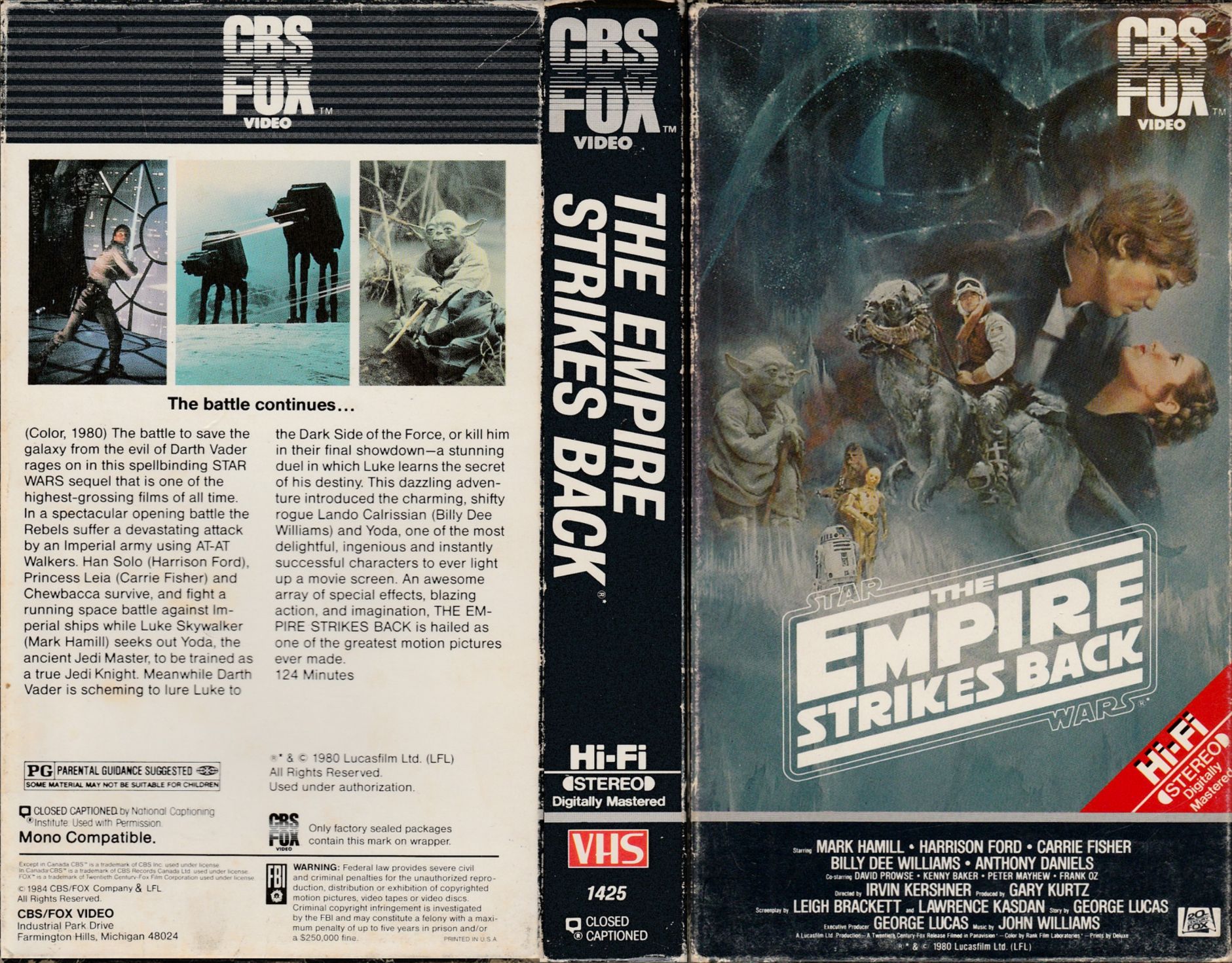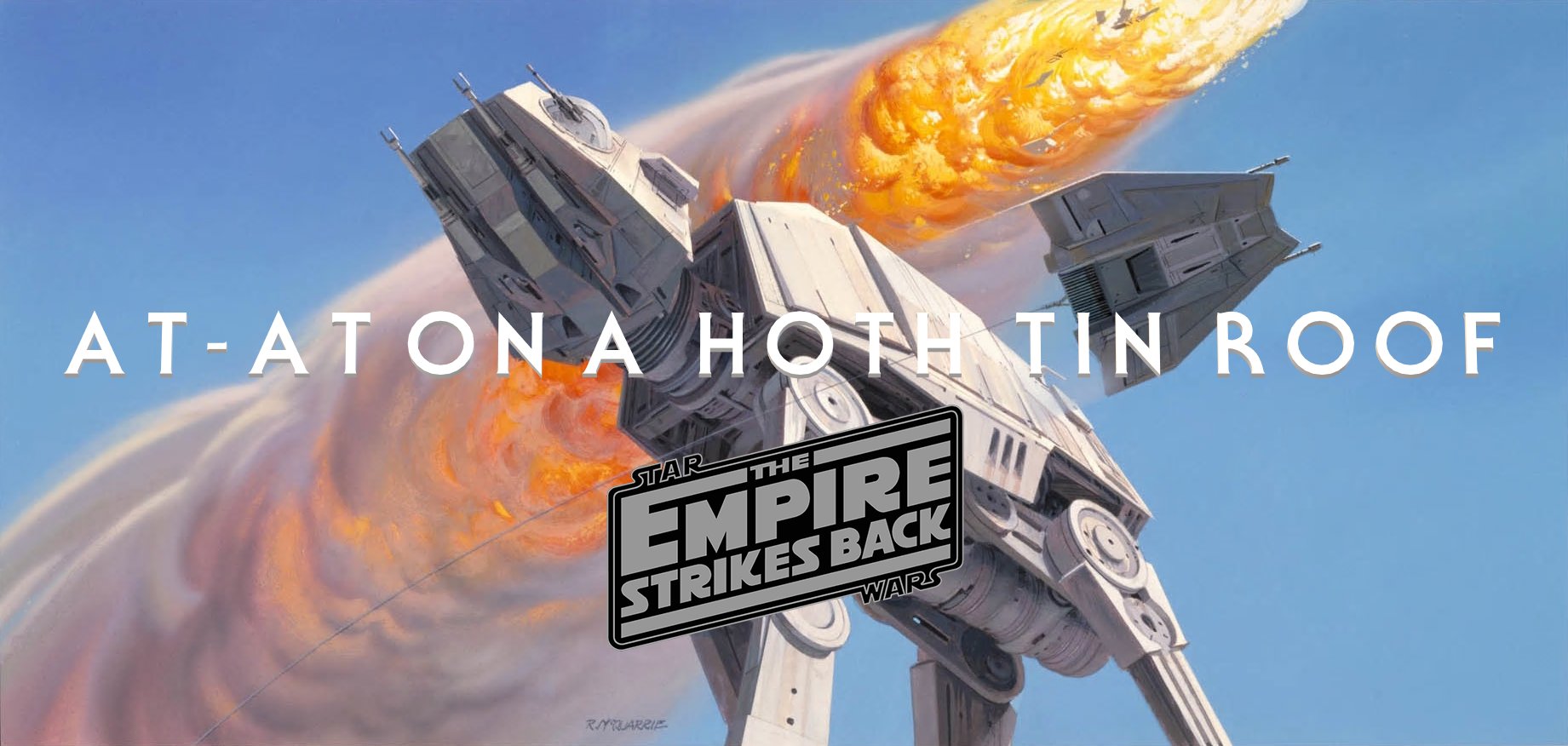
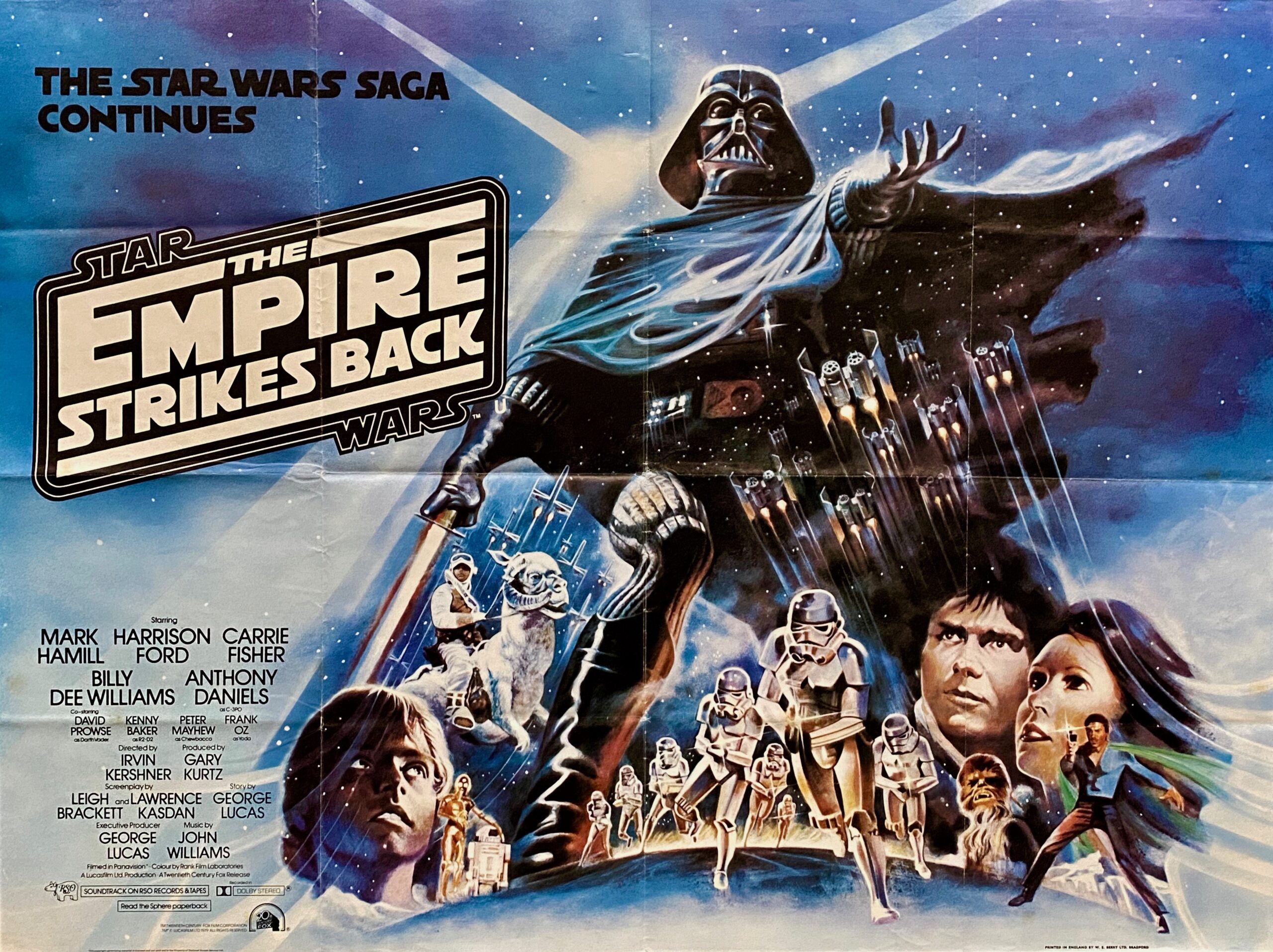
With the collective might of the Empire’s fleet dancing above them like a ballet of armageddon, director Irvin Kershner’s The Empire Strikes Back plays out like a nervous road movie without any roads. Like any road movie, every rest stop has its dramas and every wrong turn its predicaments. The Rebels are only just catching breath on their icy Hoth outpost when Episode V starts and barely catch up until halfway through Return of the Jedi’s next episode. Nothing is quite ready. Nothing quite works. Because of this improvisation – and forty years since its Royal Premiere on May 20 1980 at London’s Odeon Leicester Square – the swashbuckling drive of The Empire Strikes Back has remained ever princely in its heroism and wholly noble in its emotions. But does our plastic-toy fuelled nostalgia for a VHS galaxy that has never been that far, far away cloud the cities of our affections? Is The Empire Strikes Back more than just a lucky road movie?
As it celebrates its ruby-hued anniversary, this sky kid watches the skies of a pop-cultural icon, a Hoth behemoth and a true piece of matinee cinema art.
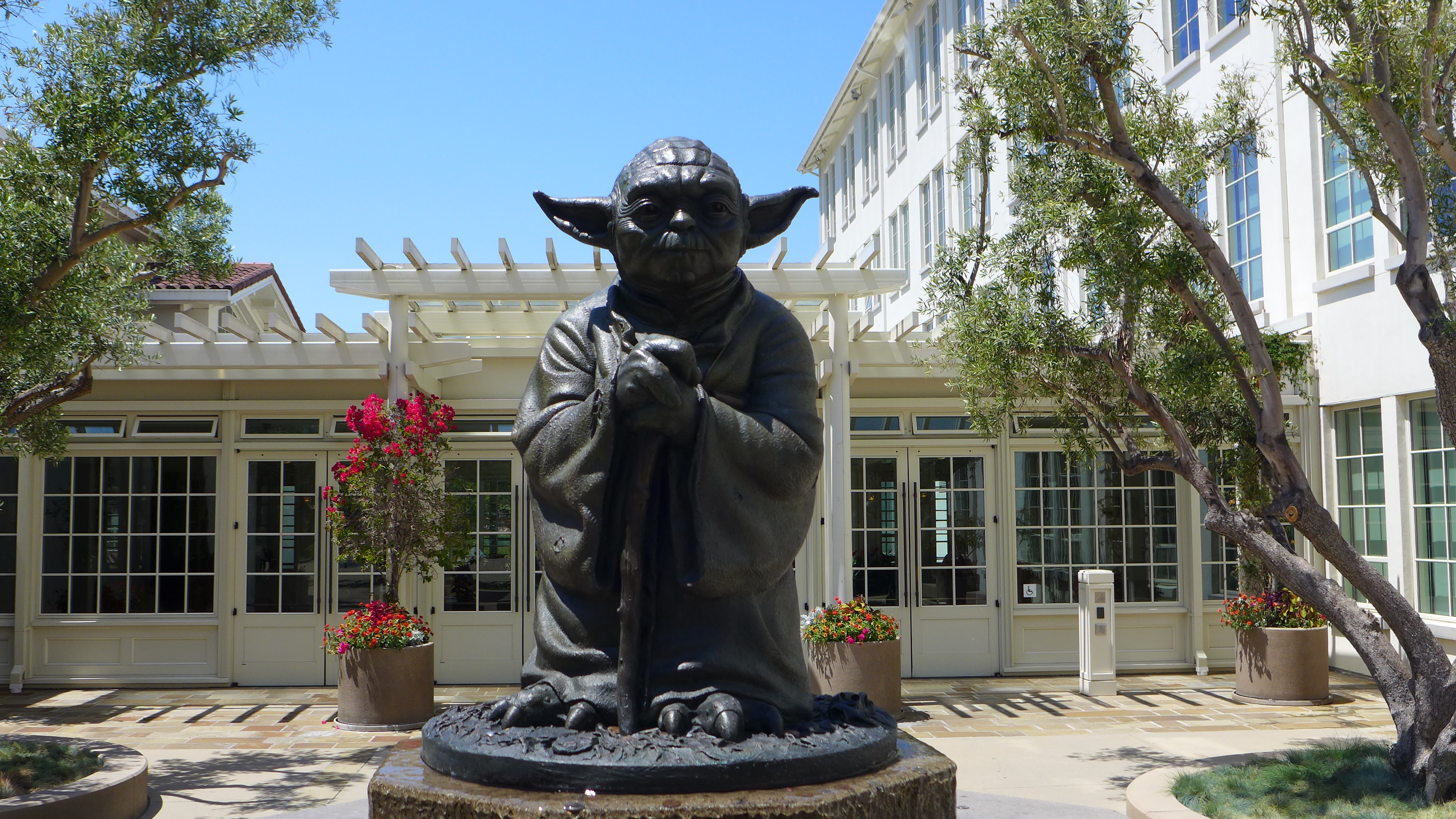
The Empire Strikes Back‘s Yoda guards the entrance to Lucasfilm Ltd, San Francisco, CA / Photo © Mark O’Connell / Watching Skies
Scaling back the sci-fi pomp and fantasy trappings of 1977’s A New Hope is a brave move on the part of George Lucas, director Irvin Kershner and writers Lawrence Kasdan and Leigh Brackett. Instead of tripling the spectacle and widening the palette of characters as expected after the biggest box office hit of all time, Empire scales itself back and becomes the opposite of what the hurried Star Wars imitators are labouring naively to cash in on. Whilst the famed attack on Hoth is expansive, ambitious and heroically achieved, all that is dramatically at stake is the Rebels getting to the emergency exits to escape. No tactics of war. No destruction of a mega weapon. The Norway-as-Hoth overture aside, the film has a great sense of containment, of being inside and letting the character dynamics widen the story rather than a constant flow of jaw-dropping visuals. A Jedi legend’s HQ is a muddy swamp with a basic pan on the stove. We don’t need another homage to Mos Eisley’s hive of scum and villainy when the sight of a ragtag band of unsavoury alien bounty hunters aboard a pristine Star Destroyer is menacing enough.
‘With its small band of likeable rogues penned into one vehicle, bickering on the bench seat about the right course of action, rubbing the enemy’s noses in it, cruising the back roads to avoid the authorities and a small, confined timescale of story – The Empire Strikes Back is actually more The Sugarland Express and American Graffiti than not.’

Just like Indiana Jones and the Temple of Doom (1984), Harrison Ford is easily at his most handsome, buoyant and narratively crucial in this second outing. Han forever crashes about like a nautical seadog with his crazed wrangling of the stubborn Falcon and a constant loss of face at its temperamental tricks. And when the original saga first takes a narrative risk of jettisoning a valued character, it is Solo who is frozen in carbonite and thrown into the story wings without warning. The Empire Strikes Back doesn’t end on a downbeat note because of who Luke Skywalker’s paternal parentage really is. It closes on the desperation of separation because Han Solo has been carted off by bounty hunter Boba Fett in a narrative rug-pull no-one saw coming.
If Luke Skywalker is the King Arthur of the piece, then Han Solo is Lancelot. It is Solo who is the first non-Jedi we see yielding a lightsaber (as he attempts to slice open a snow creature for emergency warmth in The Empire Strikes Back). It is Solo who first points a pistol at villain Darth Vader at some random Meet the Parents dinner night that goes wrong – and lives to tell the tale. It is Solo who introduces the first Star Wars alien we need to like – in the form of faithful Wookiee wing-man, Chewbacca. It is also Solo who first brings proper romance into Star Wars. When the side-bar love stories of the prequel and sequel trilogies try to work up some tender screen time, it is always the bond between Princess Leia and Han Solo in Episode V they are trying to emulate.
The glorious ‘make do and mend’ philosophy of The Empire Strikes Back is one of its glories. It is an eleventh-hour sense of character resourcefulness that the prequels missed, but which newcomers to the saga The Force Awakens, Rogue One and The Mandalorian realise is key to letting new audiences in. Episode V lends the saga its Robin Hood sense of swagger and adventure. Look at any beat of the wholly striking The Mandalorian TV series. It too is a pared down road movie peppered with allies, heroes and villains from the story world hinted at and unveiled in The Empire Strikes Back. The story mystery and blank-canvas scope of bounty hunters of Episode V is now part of the DNA of Star Wars and its future as those European cinema influences are writ large again with the casting of Werner Herzog, accidental parenthood is once again back on the story cards, an Ugnaught is an ally, Boba Fett returns for Season Two, Empire‘s box-office buddy Apollo Creed (Carl Weathers) is a co-star and a [maybe] Yoda has somewhat of a big influence on proceedings, tone and our allegiances. And if Lucasfilm’s imminent Andor TV project will have any tonal and stylistic influences – you can put a Bespin dollar it will hold the sense of spying, caper and grungy subterfuge that marks out The Empire Strikes Back.
‘In direct contrast to the rich, golden and arid hues of A New Hope and Return of the Jedi, the photography on Empire is bound to a stark, foggy and hopeless hue – a very European palette devoid of sun, space and often colour.’
For a Star Wars movie, The Empire Strikes Back is also a deceptively grisly film. From a Hoth Wampa’s vicious claws to Solo slicing open the intestines of a Tauntaun to the first peek at Vader’s mutilated scalp, the suction scares of a Mynock bat and Luke Skywalker having his father slice off his hand – Empire is definitely a product of that turn of the decade sci-fi marked by Alien, Altered States and The Thing. Empire is a film that plays with its shadows – all shot by David Cronenberg’s favoured cinematographer, Peter Suschitsky (Mars Attacks, Eastern Promises). In direct contrast to the rich, golden and arid hues of A New Hope and Return of the Jedi, the photography on Empire is bound to a stark, foggy and hopeless hue – a very European palette devoid of sun, space and often colour. The Dagobah scenes are wilfully grim and almost black and white as Star Destroyers gather like ominous storm clouds, the skies of Episode V are repeatedly flanked with snow, fog and rain. Norman Reynolds’ production design of the final duel is almost impressionistic in its abstract shapes, bursts of vapour and false perspectives echoing the rooftops and angular shadows of The Cabinet of Dr Caligari (1920). The blue and the neon orange of Cloud City’s industrial underbelly compliment the blue and red of the battling lightsabers and it is as if the whole swordfight is unfurling on the underside of the mothership from Close Encounters of the Third Kind. Unlike every other Star Wars episode and spin-off yarn to date, nothing is destroyed at the end of The Empire Strikes Back. Instead, Kasdan, Kershner and Lucas opt for the devastation of everything its lead has ever known. After ‘No Luke, I am your father’, the saga is suddenly also about dynasties and families rather than just a ‘crazy old wizard’, goose-stepping troopers and some rusting robots.

Whilst the film’s spine is a downbeat, intergalactic Grimm fairy tale about the dangers of wandering too far into the woods, it is countered by a glorious and wholly noble score from composer John Williams with his most accomplished Star Wars work and a collection of motifs and cues that define the sound of the saga for evermore. It is easily his most accomplished Star Wars work with a collection of motifs and cues that define the sound of the saga for evermore. ‘The Asteroid Field’, ‘Yoda’s Theme’, ‘Yoda and the Force’, ‘Han and Leia’, ‘The City in the Clouds’, ‘The Finale’ and of course ‘The Imperial March’ are all now standards of movie composition beyond the Star Wars canon. The Oscar-nominated score for The Empire Strikes Back is a buccaneer opera of gallant strings and heroic horns. When the Falcon cascades through an asteroid field, when a humble flotilla of Snowspeeders searches the snow sheets for missing friends, when a Jedi master lifts an X-Wing out of a swamp, when our heroes flee Cloud City in a hail of blasters, when the Falcon finally achieves the jump to lightspeed as everyone’s energy is spent – these are all afforded majestic, career-defining cues by John Williams. Just as the composer later achieves with E.T. the Extra-Terrestrial, the trust and dignity of Yoda is especially realised through Williams’ strings and that stirring leitmotif. With a diminutive playful puppet performed by The Muppets’ Frank Oz, it is down to Williams to portray the transcendent might of Yoda and the Force. We do not trust this 900-year-old pallid green goblin with the voice of Fozzie Bear until John Williams tells us via his comic horns and eventual wall of noble strings how the character is key to the sanctity and valour of these films.
‘In a single roll of the Millennium Falcon, Williams’ musical urgency switches to a romanticism and wartime adventure that keeps Episode V soaring and undulating as one of the great scores of the era.’
For a film that is ostensibly about the splintering of a resistance without narrative closure, it is Williams that voices those senses of victory and defeat that play with the themes of garrisons and friendships, heroes and fortitude. Just as the Rebel forces are bedecked in ivories and whites, so too are their musical refrains full of gallant strings and impish brass as the stomping percussion of the AT-ATs crunches heavily through the visuals. That sense of air force strings and twisting aviators is gloriously realised. In a single roll of the Millennium Falcon, Williams’ musical urgency switches to a romanticism and wartime adventure that keeps Episode V soaring and undulating as one of the great scores of the era.
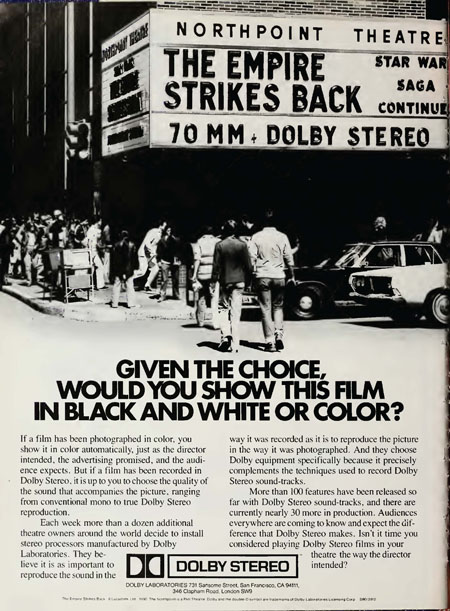 The Empire Strikes Back created the idea of the movie trilogy as both a creative enterprise and a monetary behemoth. Without A New Hope’s prologue and Return of the Jedi’s epilogue, The Empire Strikes Back can just get on with telling the story in-between without an introduction. Or closure. The narrative core and drives of the entire original Star Wars trilogy are all there in The Empire Strikes Back. The real tutelage and scope of the Force, the farm boy who becomes a man, the romance between Han and Leia, the Rebel Alliance on the back foot, the muddy dignity of Yoda, the caped swagger of Lando Calrissian, the vices and sub-industries of bounty hunters and space scoundrels, the cool intrigue of Boba Fett, the real pull of the Emperor, a Millennium Falcon and an X-Wing as support characters, the ‘make do and mend’ philosophy and the vital father and son tragedy that defines the story pulse of Star Wars for evermore. They all come to a triumphant apex in The Empire Strikes Back like no other Star Wars film before or since. And very soon the blunt climax of Empire was a landmark motif soon echoed elsewhere – most notably Rogue One and The Last Jedi, whose directors are clearly well-versed in the melancholic curtain-down glories of Star Wars ’80. Despite being a sequel to a heavily cerebral original film, Star Trek II: The Wrath of Khan (1982) was the first movie of one of the era’s most glorious swashbuckling threesomes, later completed by Star Trek III: The Search for Spock (1983) and Star Trek IV: The Voyage Home (1986). It is a trilogy so clearly influenced by the tonal triumphs of The Empire Strikes Back it closes its first two instalments on a downer aboard a ship manned by a crew licking their wounds and mourning a fallen friend. If the 1977 successes of Star Wars inadvertently forced the hand of Paramount Pictures to finally greenlight what became Star Trek: The Motion Picture (1979), it was the story impact of The Empire Strikes Back which arguably re-pointed it towards that soaring ‘Genesis Project’ of Khan, The Search for Spock and The Voyage Home. The quiet assurance that Episode V can conclude on a melancholy beat is now a blockbuster trilogy mainstay. Mad Max 2: The Road Warrior (1981), The Two Towers (2002), X2 (2003), The Dark Knight (2008), Skyfall (2012) and The Last Jedi (2017) are all darker-hued tales which close on a downbeat note because The Empire Strikes Back proved you could.
The Empire Strikes Back created the idea of the movie trilogy as both a creative enterprise and a monetary behemoth. Without A New Hope’s prologue and Return of the Jedi’s epilogue, The Empire Strikes Back can just get on with telling the story in-between without an introduction. Or closure. The narrative core and drives of the entire original Star Wars trilogy are all there in The Empire Strikes Back. The real tutelage and scope of the Force, the farm boy who becomes a man, the romance between Han and Leia, the Rebel Alliance on the back foot, the muddy dignity of Yoda, the caped swagger of Lando Calrissian, the vices and sub-industries of bounty hunters and space scoundrels, the cool intrigue of Boba Fett, the real pull of the Emperor, a Millennium Falcon and an X-Wing as support characters, the ‘make do and mend’ philosophy and the vital father and son tragedy that defines the story pulse of Star Wars for evermore. They all come to a triumphant apex in The Empire Strikes Back like no other Star Wars film before or since. And very soon the blunt climax of Empire was a landmark motif soon echoed elsewhere – most notably Rogue One and The Last Jedi, whose directors are clearly well-versed in the melancholic curtain-down glories of Star Wars ’80. Despite being a sequel to a heavily cerebral original film, Star Trek II: The Wrath of Khan (1982) was the first movie of one of the era’s most glorious swashbuckling threesomes, later completed by Star Trek III: The Search for Spock (1983) and Star Trek IV: The Voyage Home (1986). It is a trilogy so clearly influenced by the tonal triumphs of The Empire Strikes Back it closes its first two instalments on a downer aboard a ship manned by a crew licking their wounds and mourning a fallen friend. If the 1977 successes of Star Wars inadvertently forced the hand of Paramount Pictures to finally greenlight what became Star Trek: The Motion Picture (1979), it was the story impact of The Empire Strikes Back which arguably re-pointed it towards that soaring ‘Genesis Project’ of Khan, The Search for Spock and The Voyage Home. The quiet assurance that Episode V can conclude on a melancholy beat is now a blockbuster trilogy mainstay. Mad Max 2: The Road Warrior (1981), The Two Towers (2002), X2 (2003), The Dark Knight (2008), Skyfall (2012) and The Last Jedi (2017) are all darker-hued tales which close on a downbeat note because The Empire Strikes Back proved you could.
A New Hope’s beauty lies in that it doesn’t know if its seemingly random posturing as an Episode IV is going to be the first or last in George Lucas’s proposed interplanetary saga. The tag was only added to the 1977 original by the time of a 1981 re-release because of the 1980 momentum of Empire as a next chapter. Lucas may have envisioned a string of Skywalker space operas from the early San Francisco days onwards, but until those audiences, critics, kids and the box office marched to his imperial drum, that was far from assured.
When American new wave cinema evolved in the 1970s and some of its Californian-based indie flagbearers fired the starting pistol on the modern blockbuster, some panicked that the pared down intimacy of titles like American Graffiti (1973), Klute (1971), The Last Detail (1973), The Last Picture Show (1971) and The Sugarland Express (1974) would get sidetracked for the 16:9 might of Star Wars and Close Encounters of the Third Kind. With its small band of likeable rogues penned into one vehicle, bickering on the bench seat about the right course of action, rubbing the enemy’s noses in it, cruising the back roads to avoid the authorities and a small, confined timescale of story – The Empire Strikes Back is actually more Sugarland and Graffiti than not. The whole film is told in the front seats of cockpits and stolen conversations in corridors. After the opening act, very little of the film even takes place on land. Unlike A New Hope and the prequels, there is no sense of home for any of the characters. Everyone is on the run in a Rebels’ lost weekend. With their Death Star administrative hub destroyed in the previous film, Vader and his imperial Officers are resigned to posturing aboard anchorless Star Destroyers. Being rudderless and homeless again becomes a later motif of The Last Jedi (2017) and The Rise of Skywalker (2019) when the Resistance run out of both road, soldiers and fuel as the First Order’s Dreadnought looms over the starry horizon like the truck in Duel. Instead of ranks of faceless Stormtroopers and officers intimating the magnitude of the Empire, in The Empire Strikes Back we see the personalities and weaknesses of individual commanders. For all its sci-fi scope and dramatic grandeur, it is ultimately a very intimate movie – a sharp, open-ended quest with airtight dialogue and a conquering sense of purpose.
Mark O’Connell is the author of Watching Skies: Star Wars, Spielberg and Us
The Empire Strikes Back at 40: My Quest for Star Wars 2 by Mark O’Connell
